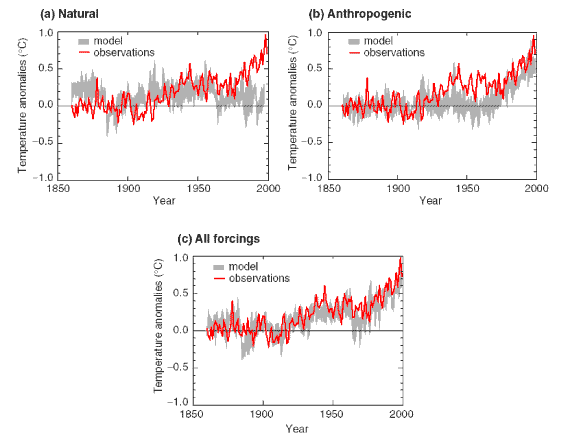 |
Climate Basics
|


Global Climate and Greenhouse Gases
The most important forcing factors, which determine
the earth's energy balance, are the solar activity, the earth's
Albedo, the clouds, aerosols and ozone and the so called Greenhouse
Gases. Greenhouse gases are molecules that absorb infrared radiation,
emitted by the Earth's surface. The most important greenhouse
gases are
- Carbon Dioxide (CO2)
- Water vapor (H2O)
- Ozone (O3)
- Methane (CH4) and
- Nitrous Oxide (N2O).
Simplified, Greenhouse gases influence the Earth energy
balance by letting pass the incoming solar radiation, while absorbing
the infrared radiation reflected by the earth's surface in the
atmosphere. This natural effect warms the earth by 33°C (the average
surface temperature is +15°C, without this natural Greenhouse
Effect it would be -18°C) and makes the earth habitable.
The Earth's annual and global mean energy balance.:
(Source: IPCC 2001)

As a consequence of human activities, the concentration
of greenhouse gases, except from water vapor, is rising. Especially
the concentration of CO2 and methane was enhanced drastically
during the last decades. Furthermore gases were emitted into the
atmospheres that do not occur naturally, such as Chlorofluorocarbons
and SF6. These gases are generated by industrial processes. All
these anthropogenic greenhouse gas emissions enhance the natural
greenhouse effect and thus the Earth's temperature.
Anthropogenic Carbon Dioxide emissions result mainly
from the combustion of fossil fuels, but also from afforestation.
Trees play a major role in removing atmospheric carbon dioxide.
Anthropogenic methane emissions arise mainly from agriculture.
TOP

Greenhouse Potential, Radiative Forcing und Global
Warming Potential
To characterize the impact of different factors on
Climate following measured values are used: Greenhouse Potential,
Radiative Forcing and Global Warming Potential.
The Greenhouse Potential is the extent of additional
energy Greenhouse Gases can absorb, by increasing their concentration.
It is dependent on their molecular characterisics.
Radiative Forcing (RF):
In an equilibrium climate state the average net radiation at the
top of the atmosphere is zero. A change in either the solar radiation
or the infrared radiation changes the net radiation. The corresponding
imbalance is called "radiative forcing". In practice, for this
purpose, the top of the troposphere (the tropopause) is taken
as the top of the atmosphere, because the stratosphere adjusts
in a matter of months to changes in the radiative balance, whereas
the surface-troposphere system adjusts much more slowly, owing
principally to the large thermal inertia of the oceans. The radiative
forcing of the surface troposphere system is then the change in
net irradiance at the tropopause after allowing for stratospheric
temperatures to re-adjust to radiative equilibrium, but with surface
and tropospheric temperatures and state held fixed at the unperturbed
values (IPCC, 2001). The radiative forcing as result of enhanced
greenhouse gas emissions from 1750 to 2000 is expected to be 2.43
Wm-2
The Global Warming Potential (GWP) bases on
the concept of Radiative forcing. It is defined as the sum of
all radiative forcing elements from one unit mass of a greenhouse
gas to that of one unit mass of carbon dioxide over a chosen period
of time. Thus it is possible to extrapolate the influence of a
greenhouse gas on the climate system for different time horizons.
In most cases the GWP refers to the period of 100 years.
|
GWP/100 years
|
|
CO2
|
1
|
|
CH4(Methane)
|
23
|
|
N2O
|
296
|
|
SF6
|
22.200
|
|
Hydrofluorocarbons
|
up to 12.000
|
|
Fully fluorinated species
|
up to 22.000
|
TOP

Natural and anthropogenic climate variations
Earth's Climate is characterized by big variations
in the past. The last 10.000 years were relatively stable and
enabled the cultural and intellectual development of mankind.
This stability could be endangered by the anthropogenic warming.
The observed warming of the 20th century is assumed to be a combination
of natural and anthropogenic factors. While the warming of the
first half of the 20th century can still be explained with natural
factors, the warming in the second half can't be explained solely
by natural factors.
Development of the Global mean surface temperature,
Source: IPCC, 2001.

Global mean surface temperature anomalies relative
to the 1880 to 1920 mean from the instrumental record compared
with ensembles of four simulations with a coupled ocean-atmosphere
climate model forced (a) with solar and volcanic forcing only,
(b) with anthropogenic forcing including well mixed greenhouse
gases, changes in stratospheric and tropospheric ozone and the
direct and indirect effects of sulphate aerosols, and (c) with
all forcing, both natural and anthropogenic. The thick line shows
the instrumental data while the thin lines show the individual
model simulations in the ensemble of four members (IPCC, 2001)
TOP

Potential extent of Global Climate Change
An increasing body of observations gives a collective
picture of a warming world and other changes in the climate system.
On the basis of different, so called Global Circulation models,
The globally averaged surface temperature is projected to increase
by 1.5 to 4.8°C until 2100. (IPCC, 2001).Due to limited computational
capacity and complex feedback mechanisms in the Climate System
thiese projections are characterized by large uncertainties.
TOP

Impacts of Climate Change
On the basis of current climate science it is very
likely that the anthropogenic enforced Climate Change will damage
the natural and human environment.
Natural systems are especially vulnerable to Climate Change because
of their limited adaptive capacity and some of these systems may
undergo significant and irreversible damage. There are many natural
systems at risk such as glaciers, coral reefs, alpine ecosystems,
boreal and tropical forests. (IPCC, 2001)
Human systems that are sensitive to Climate Change
include mainly water resources; agriculture (especially food security)
and forestry; costal zones and marine systems (fisheries); human
settlement, energy and industry, insurance and other financial
services; and human health.
Projected adverse impacts based on models and other
studies include: (IPCC, 2001)
- A general reduction in potential crop yields in
most tropical and subtropical regions as well as for most regions
in mid-latitudes
- decreased water availability for populations in
many water-scare regions, particularly in the sub-tropics
- An increase in the number of people exposed to vector-borne
(e.g. malaria) and water-borne diseases.
- A widespread increase in the risk of flooding for
many human settlements from both heavy precipitation and sea-level
rise
- Increased energy demand for space cooling due to
higher summer temperatures
TOP

Literature
IPCC
Third Assessment Report: Climate Change 2001
© IPCC, current knowledge about climate change
- Climate Change 2001: The Scientific Basis
- Climate Change 2001: Impacts, Adaptation
& Vulnerability
- Climate Change 2001: Mitigation
- Climate Change 2001: Synthesis Report
IPCC,
Special Report: "Emissions Scenarios" (2000)
Climate
of 21st Century: Changes and Risks
Scientific Facts, 2001By Dr. José L.
Lozán , Prof. Dr. Harmut Graßl , Prof. Dr. Peter
Hupfer
Climate
Change Information Kit (UNEP)
Allgemeine
Zirkulation der Atmosphäre und ihre möglichen Modifikationen
im Rahmen der globalen Klimaveränderungen
© Martin König, 1997
TOP

|








